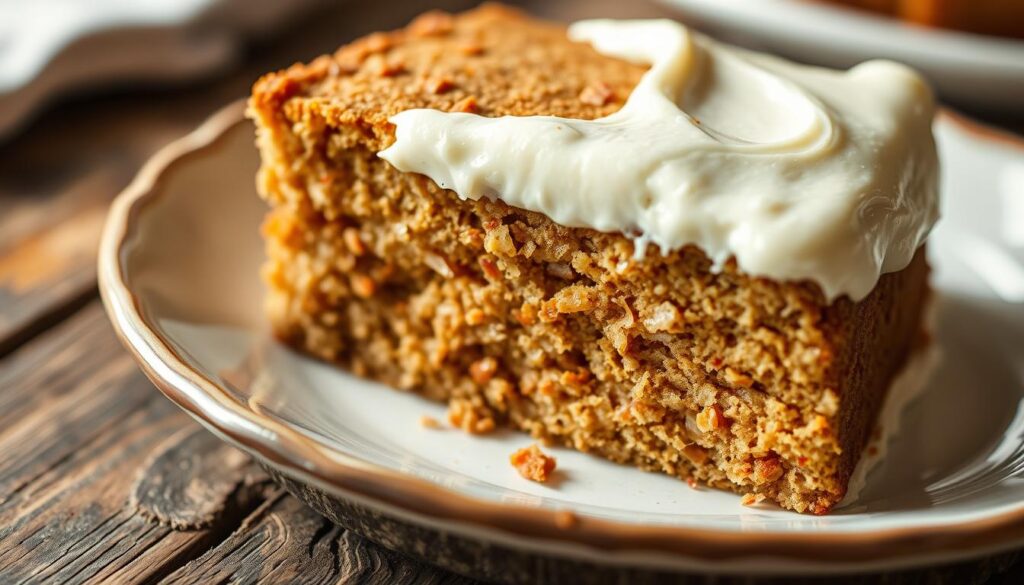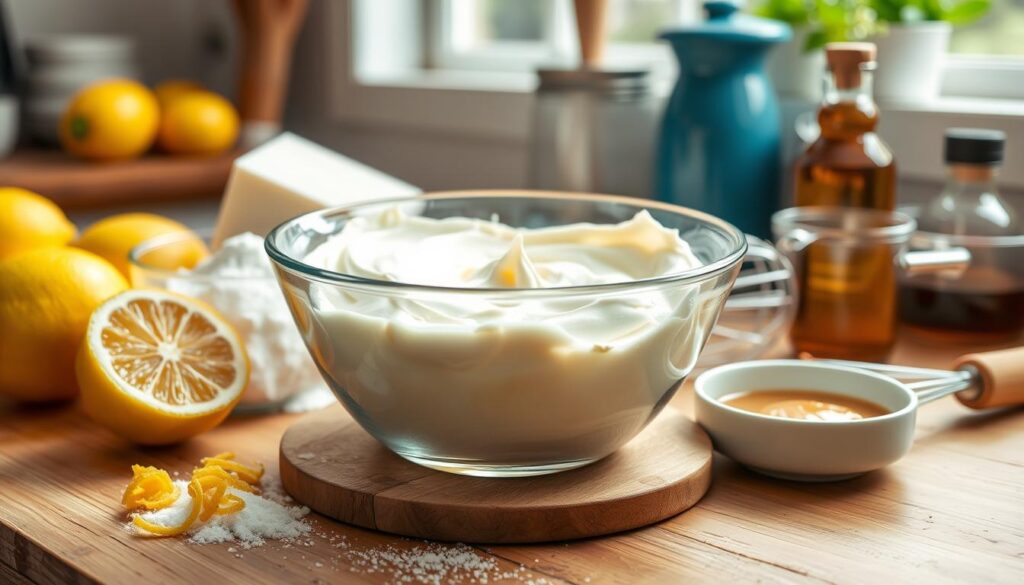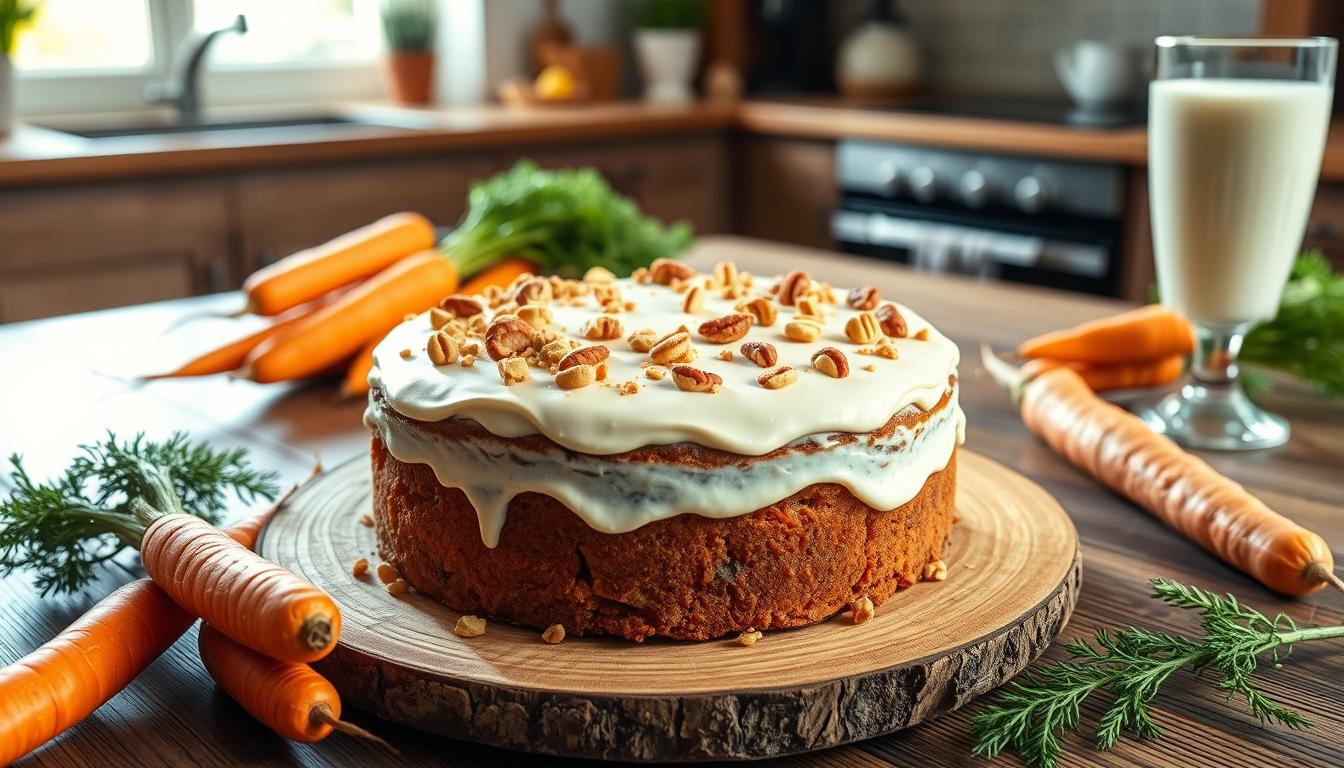Kefir Carrot Cake: Imagine biting into a slice of delicious carrot cake packed with probiotic goodness. Your quest for the ultimate healthy cake recipe ends here. This transformative kefir carrot cake redefines dessert indulgence.
Probiotic baking has changed how we think about treats. This fermented dessert masterpiece shows that health can be incredibly delectable. With a perfect balance of moisture, flavor, and nutrition, this kefir carrot cake will become your new go-to recipe for satisfying sweet cravings.
Key Takeaways
- Discover the magic of using kefir in baking for enhanced moisture
- Learn how probiotics can elevate your dessert game
- Understand the nutritional benefits of a healthier cake recipe
- Master the art of creating a moist, flavorful carrot cake
- Transform traditional baking with fermented ingredients
Understanding Kefir’s Role in Baking
Explore the world of probiotic baking with kefir. This fermented milk is more than a trend; it adds moisture, flavor, and nutrients to baked goods. It turns simple desserts into treats that are good for your gut.
The Probiotic Power of Kefir in Baked Goods
Kefir is not just another dairy product. It’s a nutritional powerhouse with probiotics that change desserts. The fermentation process makes a unique ingredient that:
- Supports gut health through beneficial bacteria
- Adds depth of flavor to baked treats
- Provides essential nutrients like calcium and vitamins
“Fermented desserts are not just delicious – they’re a way to nourish your body from the inside out.”
How Kefir Enhances Cake Moisture
Kefir is a secret weapon for the perfect cake. Its unique properties make the cake moist and tender. The acidity in kefir works with leavening agents, creating a soft, airy texture that’s delightful.
Benefits of Fermented Ingredients in Desserts
Fermented desserts are more than tasty. They offer health benefits when you use kefir in baking. The probiotics support digestive health, and the tangy flavor adds complexity to sweet treats.
| Kefir Benefit | Baking Impact |
|---|---|
| Probiotic Content | Improves Gut Health |
| Natural Acidity | Enhances Cake Texture |
| Nutrient Density | Adds Nutritional Value |
Ready to improve your baking? Kefir is your key to making desserts that are flavorful, nutritious, and exciting. Your taste buds and body will thank you.
Essential Ingredients for Kefir Carrot Cake
Making a great kefir carrot cake begins with picking top-notch ingredients. These ingredients should blend well to improve taste, texture, and health benefits.
Selecting the Right Type of Kefir
For baking, use plain, full-fat kefir with 2% milk fat or more. This fermented milk adds moisture and a slight tang. It also makes the cake tender and flavorful.
- Choose plain, unflavored kefir
- Look for kefir with 2% or higher fat content
- Avoid sweetened or fruit-flavored varieties
Best Carrots for Baking
Choosing the right carrots is key for a great kefir carrot cake. Fresh, sweet carrots add natural sweetness and moisture. Pick medium-sized, firm, and bright orange carrots for the best flavor.
Complementary Spices and Add-ins
Spices make a kefir carrot cake truly special. A mix of warm spices adds a complex flavor that makes each bite unforgettable.
| Spice | Amount | Flavor Profile |
|---|---|---|
| Ground Cinnamon | 2 tsp | Warm, sweet undertones |
| Ground Ginger | 1 tsp | Subtle heat and complexity |
| Ground Nutmeg | 1/2 tsp | Rich, nutty essence |
Adding optional mix-ins like chopped walnuts or coconut flakes can enhance your kefir carrot cake. These add texture and nutrition, improving both taste and health.
The Perfect Balance of Wet and Dry Ingredients
Making the perfect kefir cake recipe is all about finding the right mix of ingredients. It’s about combining wet and dry parts just right. This way, your cake will be moist but not too soggy or too dry.
Knowing how to balance your cake ingredients is key. Kefir adds a special touch to your baking. It brings acidity and probiotics to the mix.
“Baking is a delicate dance of chemistry and creativity” – Professional Baker’s Secret
Ingredient Separation Strategy
- Combine wet ingredients separately:
- Eggs
- Kefir
- Oil
- Vanilla extract
- Mix dry ingredients in another bowl:
- Flour
- Spices
- Baking soda
- Salt
To make a great kefir carrot cake, get the batter just right. Your batter should be more fluid than the muffin mix but thicker than the pancake batter. This will make your cake tender and moist, with everyone wanting your recipe.
Moisture-Locking Techniques
Kefir’s natural acidity helps keep your cake moist. It works with leavening agents to make the cake light and fluffy. When adding grated carrots, nuts, and coconut, mix them gently. This keeps the cake’s air bubbles intact, making it soft and delicate.
Secret Techniques for Ultimate Cake Texture
Making the perfect carrot cake needs precision and knowing the right baking techniques. The cake’s texture comes from many things, like how you prepare ingredients and mix them. Learning these secrets will make your kefir carrot cake truly special.
Proper Carrot Grating Method
The texture of your carrot cake begins with how you grate your carrots. Use a box grater with medium holes for the best texture. Don’t use a food processor, as it can make carrots too fine and wet.
- Choose fresh, firm carrots
- Grate carrots just before mixing
- Pat grated carrots with paper towels to remove excess liquid
Mixing Order and Timing
For a moist cake, follow the right baking techniques. Start by mixing wet ingredients well, then add dry ingredients slowly. Gently incorporate the ingredients and halt mixing as soon as they are united to ensure the cake stays tender and doesn’t become dense.
- Whisk wet ingredients first
- Sift dry ingredients separately
- Fold in carrots and add-ins gently
Temperature Control Tips
Controlling the oven temperature is key for a moist cake. Bake at 350°F (175°C) in a hot oven. If the top gets too brown, lower the oven by 25°F and cover with parchment paper.
“The difference between a good cake and a great cake is often in the details of preparation and baking.”

| Technique | Impact on Cake Texture |
|---|---|
| Grating Carrots | Ensures even moisture distribution |
| Gentle Mixing | Prevents tough, dense cake |
| Temperature Control | Maintains optimal moisture and browning |
Healthier Substitutions and Alternatives
Making a nutritious kefir carrot cake doesn’t mean you have to give up flavor. By choosing smart substitutions, you can make this classic dessert healthier. Let’s look at some ingredients that are good for you and taste great.
- Replace all-purpose flour with white whole wheat flour for added fiber and nutrients
- Swap refined sugar with pure maple syrup or raw honey
- Use Greek yogurt instead of traditional cream cheese frosting
- Incorporate nutrient-dense mix-ins like chopped nuts or unsweetened coconut flakes
Choosing the right fats is important too. Ditch butter for healthier options like avocado oil or extra virgin olive oil. These fats add moisture and cut down on saturated fats.
“Healthy baking is about smart ingredient swaps that enhance nutrition without compromising deliciousness.”
If you have dietary restrictions, don’t worry. There are many substitutions available. You can make dairy-free versions using coconut milk, vegan sour cream alternatives, or cashew-based creams. The key is to try different approaches until you discover what suits you best.
Your kefir carrot cake can be a nutritional powerhouse with these smart ingredient changes. Enjoy a slice that’s not only delicious but also supports your health goals.
Creating the Ideal Kefir Cream Cheese Frosting
Take your carrot cake to the next level with a rich, yet healthy cream cheese frosting. Kefir frosting adds a special touch that makes your dessert stand out. It also keeps the nutritional value high.

Making the perfect kefir frosting needs careful attention and knowing how ingredients work together. You want a smooth, creamy frosting that matches the cake’s deep flavors.
Achieving the Perfect Consistency
To make a healthy cream cheese frosting, follow these important steps:
- Strain Greek yogurt to remove excess liquid
- Blend softened cream cheese with kefir
- Gradually add powdered sugar
- Add vanilla extract for extra flavor
Natural Sweetening Options
Try different natural sweeteners to boost your frosting’s health:
| Sweetener | Flavor Profile | Sweetness Level |
|---|---|---|
| Honey | Rich, floral | Medium-high |
| Maple Syrup | Caramel-like | Medium |
| Pureed Dates | Subtle, earthy | Mild-medium |
“Achieving exceptional frosting depends on perfectly harmonizing both tangy and sweet flavors.” – Pastry Chef Recommendation
Keep in mind that each natural sweetener changes your frosting’s texture. Try different amounts to get the right mix. Make sure the kefir’s tanginess shines through.
Storage and Serving Recommendations
Keeping your carrot cake fresh is key. Your homemade kefir carrot cake needs careful storage to stay delicious. By adopting this method, you can extend the time you enjoy it.
There are a few ways to keep your cake fresh:
- Refrigerator Storage:
- Store the cake in an airtight container
- Store it in the refrigerator to maintain its freshness for up to four days
- Cover it tightly to prevent moisture loss
- Make-Ahead Preparation:
- Bake and cool the cake completely
- Wrap the unfrosted cake in plastic wrap
- Keep it stored in a cool, ambient environment and consume it within three days
- Frost it just before serving
- Freezing Options:
- Freeze the cake before adding frosting, and it will stay fresh for as long as three months
- Securely envelop it by first wrapping it with plastic wrap and then covering it with aluminum foil
- Thaw it at room temperature for 6 hours
- Or refrigerate it overnight before serving
When serving your kefir cake, take it out of the fridge 30 minutes early. This lets it warm up a bit. It makes the cake taste better and the frosting softer.
“A well-preserved cake is a delicious cake!” – Baking Enthuasiasts
Tip: Always use a clean, sharp knife for cutting. Wipe the knife clean between cuts. This makes sure your cake looks great and tastes amazing.
| Storage Method | Duration | Best Practices |
|---|---|---|
| Refrigerated (Frosted) | Up to 4 days | An airtight container, tightly covered |
| Room Temperature (Unfrosted) | Up to 3 days | Wrapped in plastic wrap |
| Freezer (Unfrosted) | Up to 3 months | Double-wrapped in plastic and foil |
Remember, proper storage is the secret to enjoying your kefir carrot cake at its absolute best!
Troubleshooting Common Baking Issues
Baking the perfect carrot cake can be tough. Knowing how to fix common problems can make your dessert turn out great every time.
Texture problems often come from small mistakes. Here are some tips to make your kefir carrot cake moist, fluffy, and tasty.
Preventing a Dense Cake
A dense cake can be a bummer. To avoid it, follow these tips:
- Incorporate fresh rising agents such as baking powder and baking soda.
- Gently combine the batter, stopping the mixing process as soon as all ingredients are barely integrated to prevent overworking it.
- Make certain that your oven has reached the necessary temperature before you begin baking
- Measure ingredients precisely
Managing Moisture Levels
Getting the moisture right is key for the perfect cake. Below are several strategies to effectively control moisture:
- Check cake doneness with a toothpick test – it should come out with a few moist crumbs
- Adjust liquid ingredients if the cake seems too wet or dry
- Use kefir to enhance moisture without making the cake soggy
- Grate carrots fresh to maintain optimal moisture
“Baking is a science, and precision is key to creating the perfect carrot cake.” – Baking Expert
Remember, baking soda is about 3-4 times stronger than baking powder. Use about 1/4 teaspoon of baking soda per 1 cup of flour for the right rise and texture.
By using these tips, you’ll be on your way to baking a moist, perfectly textured cake. It’s bound to amaze your friends and family.
Conclusion
Your search for the best kefir carrot cake is over. You’ve learned how to make a classic dessert healthier. Kefir adds moisture, probiotics, and a tangy flavor, making your cake special.
Probiotic desserts are more than a trend. They’re a smart choice for enjoying sweets while boosting your gut health. You now know how to balance ingredients, pick the best kefir, and bake perfectly. Your kefir carrot cake is not just a treat; it’s a mindful eating experience.
Baking is all about patience and practice. Every time you bake, you get better and understand how fermented ingredients change recipes. You’re not just baking a cake; you’re creating a wellness-supporting experience.
Enjoy baking, relish each bite of your probiotic dessert, and share it with joy. Your kefir carrot cake shows the tasty side of healthy, creative cooking.
FAQ
What makes kefir carrot cake different from traditional carrot cake?
Can I use dairy-free alternatives in this recipe?
How long can I store kefir carrot cake?
What type of kefir works best for baking?
How can I make the cake healthier?
Can I make this cake gluten-free?
What are the key probiotic benefits of using kefir in baking?
How do I prevent my kefir carrot cake from becoming too dense?
What did you think of our recipe?
There are no reviews yet. Be the first one to write one.

